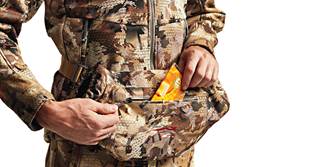Hands On Shooting
Your eyes find the target and guide your hands to it; the gun just goes along for the ride
Your eyes find the target and guide your hands to it; the gun just goes along for the ride

Given the important role your hands play in shotgun shooting, it's well worth talking about how you should use them to hold the gun and make the shot. Each hand has a different job, and both hands work in concert to get the gun to the right place and pull the trigger at the right time.
We've all heard that a shotgun should point like an extension of your body. Grip it accordingly. Hold the gun's forearm in your fingers, rather than in your cupped palm, which can cramp your wrist and impede natural movement. Extending your index finger along the forearm can help you point, rather than aim, the shotgun.
Holding the forearm with a short, choked-up grip near the receiver helps you move the gun quickly, although sometimes too quickly to control well. A long grip out toward the end of the forearm lets you point precisely but can limit your swing. A compromise position somewhere in the middle usually works best, though a short grip can help accommodate a stock that's too long, and a longer hold can make a shorter stock feel like a better fit.
Your back hand is in charge of bringing the gun to your face and pulling the trigger. The easiest way to get the right grip with your trigger hand is to put your palm flat on the stock and slide it forward to the grip. Or you can think of shaking hands with the gun. Either way, you want to be holding the pistol grip by the sidean over-the-top grip can sometimes bind you up when mounting the gun.
Neither hand should clutch the gun too tightly. A shotgun has to move fluidly with you, and a death grip only tenses your muscles and impedes movement. Hold the gun firmly enough to control it and help absorb some of the recoil, but no tighter.
The front hand moves the gun to the bird as the rear hand brings the gun to your face. The first move your hands make with the gun should be out and toward the bird. Pushing the gun out is especially important for waterfowlers, as it helps the butt remain clear of bulky jackets on its way up to your shoulder. As the muzzle moves out and toward the bird, the back hand brings the stock up to your face, then tucks it back into your shoulder pocket.
Hand speed matters, and most hunters move too fast. Moving the back hand too fast increases the chance that you won't bring the comb to the right spot on your face, and jerking the butt back into the shoulder pocket pulls the muzzle down and off of the bird. Moving the front hand too quickly breaks your connection with the target. And, since your eye is drawn to the fastest-moving object in your vision, moving too fast risks pulling your eye off the bird and onto the shotgun's bead. Think about matching the target speed with your hand speed. The phrase "slow is smooth, smooth is fast" applies perfectly to shotgun shooting.
If your timing is good, you can pull the trigger as the gun reaches your shoulder. There is no right way to pull the trigger. Press it like a rifle trigger or slap it hard, as long as the motion isn't so extreme that you yank the muzzle off target.
After the shot, your back hand has to keep the gun snug against your shoulder while your leading hand keeps pointing at the bird. Too many people snatch the gun off their shoulder or let it drop as they're pulling the trigger. Your hands aren't done working until the bird is down. Then they're free to reload, receive a high-five, and reach for a cup of coffee.

It's a struggle to load a gun, disengage a safety, and sometimes even feel the gun's trigger when your hands are cold and numb. Most gloves that are warm enough to make a difference are too bulky to shoot with. A muff with a handwarmer inside lets you hunt glove-free while keeping your hands toasty between shots. For really cold weather I use a pair of electric ski mittens. Mittens are warmer than gloves, and easier to slide off and put back on, especially with wet hands. I pull them off to call and shoot.
Ducks Unlimited uses cookies to enhance your browsing experience, optimize site functionality, analyze traffic, and deliver personalized advertising through third parties. By continuing to use this site, you agree to our use of cookies. View Privacy Policy